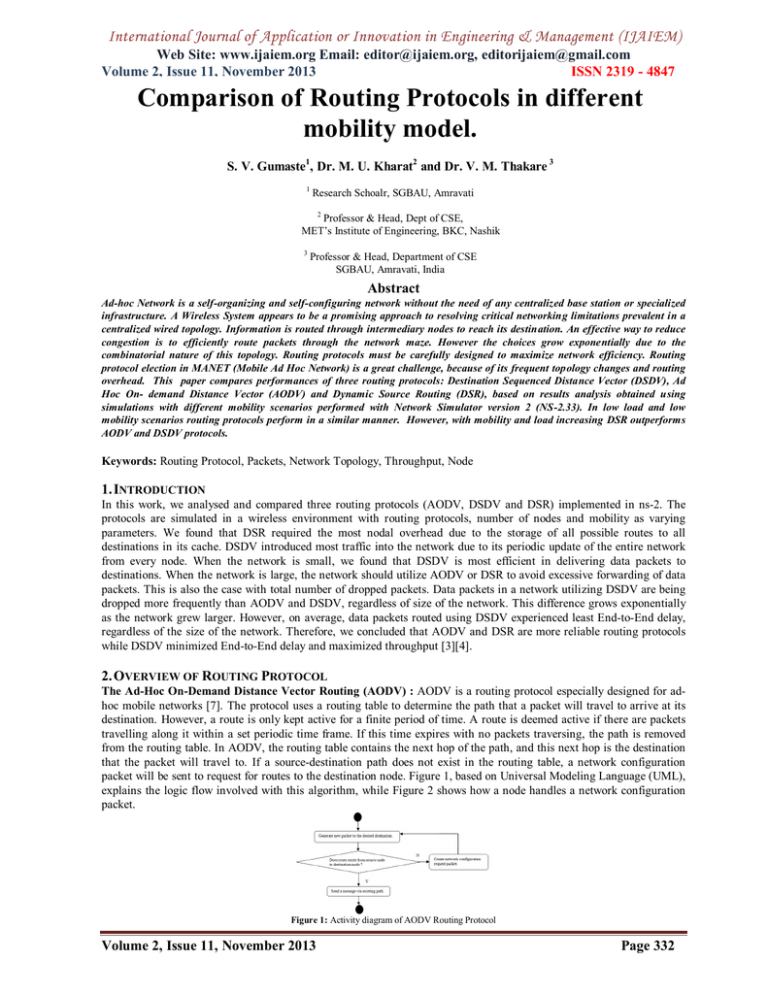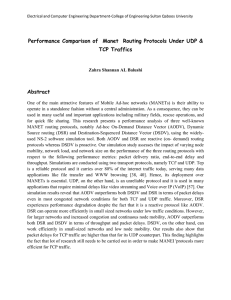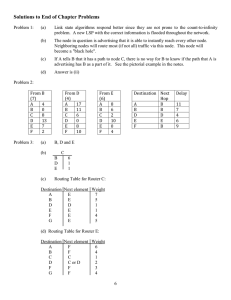Comparison of Routing Protocols in different mobility model.
advertisement

International Journal of Application or Innovation in Engineering & Management (IJAIEM) Web Site: www.ijaiem.org Email: editor@ijaiem.org, editorijaiem@gmail.com Volume 2, Issue 11, November 2013 ISSN 2319 - 4847 Comparison of Routing Protocols in different mobility model. S. V. Gumaste1, Dr. M. U. Kharat2 and Dr. V. M. Thakare 3 1 Research Schoalr, SGBAU, Amravati 2 Professor & Head, Dept of CSE, MET’s Institute of Engineering, BKC, Nashik 3 Professor & Head, Department of CSE SGBAU, Amravati, India Abstract Ad-hoc Network is a self-organizing and self-configuring network without the need of any centralized base station or specialized infrastructure. A Wireless System appears to be a promising approach to resolving critical networking limitations prevalent in a centralized wired topology. Information is routed through intermediary nodes to reach its destination. An effective way to reduce congestion is to efficiently route packets through the network maze. However the choices grow exponentially due to the combinatorial nature of this topology. Routing protocols must be carefully designed to maximize network efficiency. Routing protocol election in MANET (Mobile Ad Hoc Network) is a great challenge, because of its frequent topology changes and routing overhead. This paper compares performances of three routing protocols: Destination Sequenced Distance Vector (DSDV), Ad Hoc On- demand Distance Vector (AODV) and Dynamic Source Routing (DSR), based on results analysis obtained using simulations with different mobility scenarios performed with Network Simulator version 2 (NS-2.33). In low load and low mobility scenarios routing protocols perform in a similar manner. However, with mobility and load increasing DSR outperforms AODV and DSDV protocols. Keywords: Routing Protocol, Packets, Network Topology, Throughput, Node 1. INTRODUCTION In this work, we analysed and compared three routing protocols (AODV, DSDV and DSR) implemented in ns-2. The protocols are simulated in a wireless environment with routing protocols, number of nodes and mobility as varying parameters. We found that DSR required the most nodal overhead due to the storage of all possible routes to all destinations in its cache. DSDV introduced most traffic into the network due to its periodic update of the entire network from every node. When the network is small, we found that DSDV is most efficient in delivering data packets to destinations. When the network is large, the network should utilize AODV or DSR to avoid excessive forwarding of data packets. This is also the case with total number of dropped packets. Data packets in a network utilizing DSDV are being dropped more frequently than AODV and DSDV, regardless of size of the network. This difference grows exponentially as the network grew larger. However, on average, data packets routed using DSDV experienced least End-to-End delay, regardless of the size of the network. Therefore, we concluded that AODV and DSR are more reliable routing protocols while DSDV minimized End-to-End delay and maximized throughput [3][4]. 2. OVERVIEW OF ROUTING PROTOCOL The Ad-Hoc On-Demand Distance Vector Routing (AODV) : AODV is a routing protocol especially designed for adhoc mobile networks [7]. The protocol uses a routing table to determine the path that a packet will travel to arrive at its destination. However, a route is only kept active for a finite period of time. A route is deemed active if there are packets travelling along it within a set periodic time frame. If this time expires with no packets traversing, the path is removed from the routing table. In AODV, the routing table contains the next hop of the path, and this next hop is the destination that the packet will travel to. If a source-destination path does not exist in the routing table, a network configuration packet will be sent to request for routes to the destination node. Figure 1, based on Universal Modeling Language (UML), explains the logic flow involved with this algorithm, while Figure 2 shows how a node handles a network configuration packet. Figure 1: Activity diagram of AODV Routing Protocol Volume 2, Issue 11, November 2013 Page 332 International Journal of Application or Innovation in Engineering & Management (IJAIEM) Web Site: www.ijaiem.org Email: editor@ijaiem.org, editorijaiem@gmail.com Volume 2, Issue 11, November 2013 ISSN 2319 - 4847 It is also important to note that AODV is able utilizing both multicast and unicast. When propagating a network configuration packet, the packet can be multicasted to the other members of the multicast group. Figure 2: Activity diagram of AODV Network configuration packet. Dynamic Source Routing (DSR): Perhaps the simplest of the three routing protocols, Dynamic Source Routing (DSR) incorporates two different mechanisms to keep track of available routes throughout the network. The two mechanisms are route-discovery and route-maintenance [8]. Furthermore, as the indicated by its name, this protocol is only initiated when there is a request to send a packet from a source node to a destination node. Hence, there is no additional overhead required to maintain a “current-view” of the network topology. This “current-view” is in fact, the actual path from the source node to the destination node. As a result, the routing table within DSR contains multiple paths to a destination node, as opposed to just keeping the next hop within a routing table, such as the case in AODV. Figure 3 is a UML activity diagram that summarises flow of the protocol. When a packet is sent from node A to node B, a check is first made to see if a route exists. If the route already does not exist, the route-discovery mechanism is initiated and a network configuration packet is sent to discover the path to the destination. If the inquiry is replied with an acknowledgement, the route is placed into the source’s cache for future references. The packet is then sent via this newly-discovered path [2]. If a path already exists in the cache, the routemaintenance mechanism is initiated and the packet is sent. The source node waits for an acknowledgement from the destination node. This acknowledgement serves as an indication that the route still exists. A important parameter of this protocol is to send a specific number of acknowledgments. Hence, a successfully-sent packet would receive equal number of acknowledgements from the destination node. If this does not happen, then the route is treated as a broken route and the route-discovery mechanism is initiated for every node on the broken path [5]. Figure 3: Activity diagram for logic flow in DSR. Destination-Sequenced Distance Vector Routing (DSDV): DSDV is an extension of the Bellman-Ford algorithm, which involves finding the shortest path between two points [9]. There is a high overhead because new networkconfiguration packets are constantly being broadcasted and existing network routes are constantly updated. This overhead is essential because the network-configuration packets are used to keep a “current view” of the network topology. This “current view” however, is only stored in the form of the next hop the packet should travel along a set path in the routing table. When a network-configuration packet is received by a node, there are two actions that are taken. First, the route information in the network-configuration packet is compared node’s cache. If a shorter path exists, the shortest path will be used to replace the existing path. If the path does not exist in the cache, then this path is copied into the routing table. This task, although it is simple, is vital to the functionality of the protocol because it ensures that every node has a copy of the shortest path from a source node to a destination node. The second action performed is to forward networkconfiguration packet to all the other connected nodes. This is done to ensure that other nodes have access to the most recent network routes. Volume 2, Issue 11, November 2013 Page 333 International Journal of Application or Innovation in Engineering & Management (IJAIEM) Web Site: www.ijaiem.org Email: editor@ijaiem.org, editorijaiem@gmail.com Volume 2, Issue 11, November 2013 ISSN 2319 - 4847 3. PARAMETER SELECTION Communication Model: In our simulation, we use constant bit rate (CBR) traffic sources. When defining the parameters of the Communication model, we experimented with 50 and 100 nodes; the sending rate used was 4 packets per second, and the network contains 10 CBR sources. Table 1: Parameters of communication model Parameter Value Traffic type CBR Number of nodes 50 and 100 nodes Number of data sources 10 connections Transmission rate 4 packets/second Table 2: Parameters used in the movement model Parameter Value Simulator Ns-2 (Version 2.33) Simulation time 300 seconds Area of the network 500m x 500m Number of nodes 50 and 100 nodes Pause time 1 seconds Maximum speed of nodes 5, 10, 25, 50 and 100 m/sec Transmission range 250 m Mobility model Random waypoint Movement Model: In our simulations, we use the random waypoint model [1][6] where each node begins the simulation by remaining stationary for pause time seconds. It then selects a random destination in the 500m x 500m space and moves to that destination at a speed distributed uniformly between 1 and some maximum speed. Upon reaching the destination, the node pauses again for pause time seconds, selects another destination, and proceeds there as previously described, repeating this behaviour for the duration of the simulation. We fix the area to be 500 x 500 meters, and the simulation time to be 300 seconds. Meanwhile, we vary the number of nodes to compare the protocols performance for low and high density, pause times 1 second, and speed of nodes 5, 10, 25, 50 and 100 m/sec (in the range of different speed). Table 2 lists the movement parameters of the simulations. 4. PERFORMANCE METRIC For network simulation, there are several performance metrics which is used to evaluate the performance. In simulation purpose we have used three performance metrics. 4.1 Packet Delivery Ratio Packet delivery ratio is the ratio of number of packets received at the destination to the number of packets sent from the source. The performance is better when packet delivery ratio is high. AODV performance is high even in high mobility scenario (Figure 4 & 5), DSR initially shows considerable performance but will not maintain the same performance in high mobility scenario. Figure 4: Packet delivery ratio with 50 nodes Volume 2, Issue 11, November 2013 Figure 5: Packet delivery ratio with 100 nodes Page 334 International Journal of Application or Innovation in Engineering & Management (IJAIEM) Web Site: www.ijaiem.org Email: editor@ijaiem.org, editorijaiem@gmail.com Volume 2, Issue 11, November 2013 ISSN 2319 - 4847 3.2 Average End-to-End Delay This is the average time delay for data packets from the source node to the destination node. To find out the end-to end delay the difference of packet sent and received time was stored and then dividing the total time difference over the total number of packet received gave the average end-to end delay for the received packets. The performance is better when packet end-to-end delay is low. Figure 6: End to End Delay with 50 nodes Figure 7: End to End Delay with 100 nodes DSDV shows better performance but with more load (in high mobility scenario) DSR is compatible with DSDV (Figure 6 & 7). 3.3 Normalized Routing Load Number of routing packets “transmitted” per data packet “delivered” at destination. Each hop-wise transmission of a routing is counted as one transmission. It is the sum of all control packet sent by all node in network to discover and maintain route. NRL = Routing Packet/Received Packets (Figure 8 & 9). Figure 8: Normalized routing load with 50 nodes Figure 9: Normalized routing load with 100 nodes 3.4 Average Throughput It is defined as the ratio of total packets received to the simulation time. [6] The simulations were performed using Network Simulator Ns-2 (www.isi.edu/nsnam/ns), popular in the ad- hoc networking community. The mobility model used is Random Way point Model. The traffic sources are CBR (continuous bit –rate), number of data connections is 10, data packet size is 512 byte and data sending rate is 4 packet/second. The source-destination pairs are spread randomly over the network in a rectangular filed of 500 m X 500 m. During the simulation, each node starts its journey from a random spot to a random chosen destination. Once the destination is reached, the node takes a rest period of time in second and another random destination is chosen after that pause time. This process repeats throughout the simulation, causing continuous changes in the topology of the underlying network. The simulation time is 300 seconds and maximum speed of nodes is varying with 1, 5, 10, 25, 50 and 100 m/sec. The interface queue is 150- packet drop-tail priority queue. Three types of network scenario for different number of nodes are generated [7]. 1. Wireless scenario with fixed position of nodes. 2. Wireless scenario with movable nodes (traffic generated by cbrgen and setdest). 3. Wireless scenario with movable nodes giving time slices for communication. Volume 2, Issue 11, November 2013 Page 335 International Journal of Application or Innovation in Engineering & Management (IJAIEM) Web Site: www.ijaiem.org Email: editor@ijaiem.org, editorijaiem@gmail.com Volume 2, Issue 11, November 2013 ISSN 2319 - 4847 Figure10: Throughput with 50 nodes Figure 11: Throughput with 100 nodes 5. CONCLUSIONS Considering the type of application and scenario, we need to select the routing protocols. From the above analysis, for few parameters like PDR, End to end Delay, AODV and DSDV protocols exhibit better performance. REFERENCES [1] D. Johnson, Y., Hu, D. Maltz, “The Dynamic Source Routing Protocol (DSR) for ad-hoc networks”, [online] http://tools.ietf.org/html/rfc4728 [2] Samir R. Das, Samir R. Das, Elizabeth M. Royer, Mahesh K. Marina, “ Performance Comparison of Two Ondemand Routing Protocols for Ad Hoc Networks”, IEEE INFOCOM 2000. [3] http://tools.ietf.org/html/draft-ietf-manet-dsr-00 [4] http://www.nsnam.org/docs/release/3.16/doxygen/classns3_1_1dsr_1_1_dsr_option_rrep_header.html [5] Ioannis Chatzigiannakis, Sotiris Nikoletseas, Paul Spirakis, Journal of Parallel and Distributed Computing, Volume 63, Pages:58 –74, 2003. [Online] http://portal.acm.org/citation.cfm?id=782546.782553&dl=GUI DE&dl=GUIDE [6] Mina Vajed Khiavi, Shahram Jamali, Sajjad Jahanbakhsh Gudakahriz, “Performance Comparison of AODV, DSDV, DSR Routing Protocols in MANETs”, International Research Journal of Applied and Basic Sciences, Vol., 3 (7), 1429-1436, 2012 [7] Er. Saurabh Mittal, Pinki, “Performance Evaluation of AODV, DSR, DSDV Routing Protocols” International Journal of Multidisciplinary Research Vol.2 Issue 2, February 2012 [8] Craparo, Emily M., Jonathan P. How, and Eytan Modiano. “Throughput Optimization in Mobile Backbone Networks.” IEEE Transactions on Mobile Computing 10 (2011): 560-572. [9] Shyamrao V Gumaste, Dr. M. U. Kharat, Dr. V. M. Thakare, V. T. Kharat “Routing Algorithms- Overview”, International Journal of Innovations in Engineering and Management, Vol. 2; No. 1: ISSN: 2319-3344 (Jan- June 2013) AUTHOR S. V. Gumaste, BE (CSE), ME (CSE), was graduated at BLDE Associations College of Engineering & Technology, Bijapur (Karnataka University, Dharwar), completed his post-graduation from COE, Badnera (Sant Gadge Baba Amravati University, Amravti). Dr. M. U. Kharat, BE, MS, Ph.D. was educated at Amravati University. Presently he is working at the Institute of Engineering, Bhujbal Knowledge City, Nashik, Maharastra, India, as Professor & Head of the Computer Engineering Department. Dr. V. M. Thakare, Head, Department of CSE, Sant Gadge Baba Amravati University, Amravati. He has worked in various capacities in academic institutions at the level of Professor, Head of Computer Engineering Department. His areas of interest include Digital image/Signal Processing, Computer Networks. Volume 2, Issue 11, November 2013 Page 336







